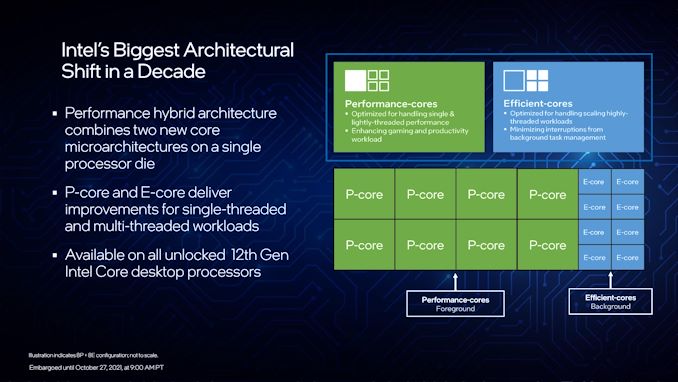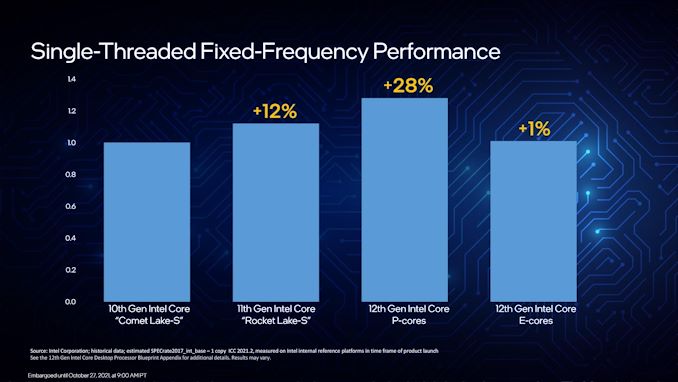Intel 12th Gen Core Alder Lake for Desktops: Top SKUs Only, Coming November 4th
by Dr. Ian Cutress on October 27, 2021 12:00 PM EST- Posted in
- CPUs
- Intel
- DDR4
- DDR5
- PCIe 5.0
- Alder Lake
- Intel 7
- 12th Gen Core
- Z690
A Hybrid/Heterogeneous Design
Developing a processor with two different types of core is not a new concept – there are billions of smartphones that have exactly that inside them, running Android or iOS, as well as IoT and embedded systems. We’ve also seen it on Windows, cropping up on Qualcomm’s Windows on Snapdragon mobile notebooks, as well as Intel’s previous Lakefield design. Lakefield was the first x86 hybrid design in that context, and Alder Lake is the more mass-market realization of that plan.
A processor with two different types of core disrupts the typical view of how we might assume a computer works. At the basic level, it has been taught that a modern machine is consistent – every CPU has the same performance, processes the same data at the same rate, has the same latency to memory, the same latency to each other, and everything is equal. This is a straightforward homogenous design that’s very easy to write software for.
Once we start considering that not every core has the same latency to memory, moving up to a situation where there are different aspects of a chip that do different things at different speeds and efficiencies, now we move into a heterogeneous design scenario. In this instance, it becomes more complex to understand what resources are available, and how to use them in the best light. Obviously, it makes sense to make it all transparent to the user.
With Intel’s Alder Lake, we have two types of cores: high performance/P-cores, built on the Golden Cove microarchitecture, and high efficiency/E-cores, built on the Gracemont microarchitecture. Each of these cores are designed for different optimization points – P-cores have a super-wide performance window and go for peak performance, while E-cores focus on saving power at half the frequency, or lower, where the P-core might be inefficient.
This means that if there is a background task waiting on data, or something that isn’t latency-sensitive, it can work on the E-cores in the background and save power. When a user needs speed and power, the system can load up the P-cores with work so it can finish the fastest. Alternatively, if a workload is more throughput sensitive than latency-sensitive, it can be split across both P-cores and E-cores for peak throughput.
For performance, Intel lists a single P-core as ~19% better than a core in Rocket Lake 11th Gen, while a single E-core can offer better performance than a Comet Lake 10th Gen core. Efficiency is similarly aimed to be competitive, with Intel saying a Core i9-12900K with all 16C/24T running at a fixed 65 W will equal its previous generation Core i9-11900K 8C/16T flagship at 250 W. A lot of that will be that having more cores at a lower frequency is more efficient than a few cores at peak frequency (as we see in GPUs), however an effective 4x performance per watt improvement requires deeper investigation in our review.
As a result, the P-cores and E-cores look very different. A deeper explanation can be found in our Alder Lake microarchitecture deep dive, but the E-cores end up being much smaller, such that four of them are roughly in the same area as a single P-core. This creates an interesting dynamic, as Intel highlighted back at its Architecture Day: A single P-core provides the best latency-sensitive performance, but a group of E-cores would beat a P-core in performance per watt, arguably at the same performance level.
However, one big question in all of this is how these workloads end up on the right cores in the first place? Enter Thread Director (more on the next page).
A Word on L1, L2, and L3 Cache
Users with an astute eye will notice that Intel’s diagrams relating to core counts and cache amounts are representations, and some of the numbers on a deeper inspection need some explanation.
For the cores, the processor design is physically split into 10 segments.
A segment contains either a P-core or a set of four E-cores, due to their relative size and functionality. Each P-core has 1.25 MiB of private L2 cache, which a group of four E-cores has 2 MiB of shared L2 cache.
This is backed by a large shared L3 cache, totaling 30 MiB. Intel’s diagram shows that there are 10 LLC segments which should mean 3.0 MiB each, right? However, moving from Core i9 to Core i7, we only lose one segment (one group of four E-cores), so how come 5.0 MiB is lost from the total L3? Looking at the processor tables makes less sense.
Please note that the following is conjecture; we're awaiting confirmation from Intel that this is indeed the case.
It’s because there are more than 10 LLC slices – there’s actually 12 of them, and they’re each 2.5 MiB. It’s likely that either each group of E-cores has two slices each, or there are extra ring stops for more cache.
Each of the P-cores has a 2.5 MiB slice of L3 cache, with eight cores making 20 MiB of the total. This leaves 10 MiB between two groups of four E-cores, suggesting that either each group has 5.0 MiB of L3 cache split into two 2.5 MiB slices, or there are two extra LLC slices on Intel’s interconnect.
| Alder Lake Cache | |||||||
| AnandTech | Cores P+E/T |
L2 Cache |
L3 Cache |
IGP | Base W |
Turbo W |
Price $1ku |
| i9-12900K | 8+8/24 | 8x1.25 2x2.00 |
30 | 770 | 125 | 241 | $589 |
| i9-12900KF | 8+8/24 | 8x1.25 2x2.00 |
30 | - | 125 | 241 | $564 |
| i7-12700K | 8+4/20 | 8x1.25 1x2.00 |
25 | 770 | 125 | 190 | $409 |
| i7-12700KF | 8+4/20 | 8x1.25 1x2.00 |
25 | - | 125 | 190 | $384 |
| i5-12600K | 6+4/20 | 6x1.25 1x2.00 |
20 | 770 | 125 | 150 | $289 |
| i5-12600KF | 6+4/20 | 6.125 1x200 |
20 | - | 125 | 150 | $264 |
This is important because moving from Core i9 to Core i7, we lose 4xE-cores, but also lose 5.0 MiB of L3 cache, making 25 MiB as listed in the table. Then from Core i7 to Core i5, two P-cores are lost, totaling another 5.0 MiB of L3 cache, going down to 20 MiB. So while Intel’s diagram shows 10 distinct core/LLC segments, there are actually 12. I suspect that if both sets of E-cores are disabled, so we end up with a processor with eight P-cores, 20 MiB of L3 cache will be shown.













395 Comments
View All Comments
Wrs - Tuesday, November 2, 2021 - link
The point isn't about Thunberg. Whatever she says does not change the laws of nature. If she gets us to think in a more educated way about the impact of all our little decisions, that’s a good thing. If she gets us to discover more about the physical processes happening around us, that’s awesome. Just know that identifiably man-made problems are not necessarily the ones we need to solve. We fight forest fires caused by lightning. Vaccinate animals against viruses. If need be, I believe we’d try to fragment an asteroid heading our way. How does our impact on Earth compare to that 10-mile-wide rock 66 million years ago? Still standing by humanity’s record penchant for causing extinctions?A CPU is a tool to do some mechanical thinking. How we fabricate, power, and use it can leave traces on Earth. So is the case for everything else we have. Those traces can accumulate and come back to bite us. But it is not as simple as lower peak wattage is better. We need to do much more nuanced thinking than that.
mode_13h - Friday, November 5, 2021 - link
> We fight forest fires caused by lightning.Focusing on what sparks the fires is missing the point. Forests are getting dried out by changes in rainfall and increasing heat. That's what makes the difference between the sort of containable forest fires we've seen in the past and the kind of out-of-control conflagrations we're seeing today.
> Vaccinate animals against viruses.
Wildlife? Really? You're going to vaccinate like a billion bats? And against viruses we don't even know about, yet? Good luck with that.
> How does our impact on Earth compare to that 10-mile-wide rock 66 million years ago?
We're living through the greatest mass-extinction since that time. Do you think that's okay?
> it is not as simple as lower peak wattage is better.
Some disagree with that. I'm less a fan of regulating the efficiency of energy sinks, however. I'd rather see traditional externalities priced into energy costs. Then, let the market do its thing and optimize energy use for us. Unfortunately, carbon pricing has never really caught on, in a big way.
shabby - Wednesday, October 27, 2021 - link
Hey Ian will you be doing a ddr4 vs ddr5 comparison too in the review? Ddr5 prices seem to be double compared to ddr4 on Newegg now.Roy2002 - Wednesday, October 27, 2021 - link
Can motherboard makers put DDR4 slots along with DDR5 slots?shabby - Wednesday, October 27, 2021 - link
Seems like no, in the ddr5 section it says that intel requests oems not to do that.Hifihedgehog - Wednesday, October 27, 2021 - link
OEMs, ignore Intel's stupid requests. We will buy DDR4 and DDR5 mixed slot motherboards!Spunjji - Thursday, October 28, 2021 - link
Bit late to be making that demand, tbhOFelix - Wednesday, October 27, 2021 - link
Looking forward to the day that Intel get their power draw under control:i9-12900K 241W
R9 5900X 142W
Gothmoth - Wednesday, October 27, 2021 - link
i am all for competition.but instead of praising the new intel architecture.... reviewers should have a close look if that´s not just a BRUTE FORCE approach to be competitive.
shabby - Wednesday, October 27, 2021 - link
It seems since zen came out that's all intel has been doing, auto overclocking the cpu till the cpu hits 90c or so and keep it there. Can't blame them since there seems to be headroom unlike in the zen architecture.